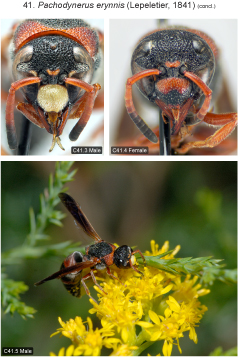
| Home | Table of contents | Keys | Species list | Glossary | Image data | PDF | Cite this article | Feedback | Updates |
Identification Atlas of the Vespidae (Hymenoptera, Aculeata) of the northeastern Nearctic region
CJAI 05, February 19, 2008
doi: 10.3752/cjai.2008.05
Matthias Buck, Stephen A. Marshall, and David K.B. Cheung
Department of Environmental Biology, University of Guelph, Guelph, Ontario, Canada N1G 2W1
41. Pachodynerus erynnis (Lepeletier, 1841)
Figs A4.1, 3; B2.20, 37; C41.1–5.

|

|
Species recognition. Habitus similar to Euodynerus but easily distinguished from that genus both by structure and by colour. Pachodynerus erynnis differs from other eastern Canadian Eumeninae by the presence of a complete humeral carina that reaches the hind margin of the pronotum, the strongly developed and sharp-edged propodeal carina, which curves anteriorly about midway between the propodeal angle and the submarginal carina, and the simple, 10-segmented male flagellum. The colouration is unique in completely lacking pale (yellow or ivory) markings on the meso- and metasoma (Leptochilus acolhuus from the southeastern U.S. are similarly coloured but structurally very different). Yellow markings are only present in the male and restricted to the clypeus, labrum, interantennal spot, and inner orbits above clypeus. Both male and female are extensively marked with ferruginous, including scape, pedicel and basal three flagellomeres, most of mandible, pronotum, metanotum and metasomal segment 1 (excluding anterior vertical surface of tergum 1), tegula, legs (excluding most or all of coxae), upper surface of propodeum, and apical fasciae on tergum and sternum 2.
Variation. Fore wing length ca. 9 mm (♂♂), 10.5–11 mm (♀♀). The ferruginous markings sometimes have a yellowish tinge, especially the lower surface of the scape, the metanotum, apical fasciae of tergum and sternum 2. Fascia of sternum 2 sometimes interrupted medially. Apical segments of metasoma sometimes marked ferruginous.
Distribution. The core range of this species includes the Atlantic and Gulf coast states from NC to FL and west to LA (Willink and Roig-Alsina 1998). Outside this range the species has only been found three times: in DC (Bohart 1951), MA (Krombein 1979) and southern Ontario (new record). The record from Washington D.C. was considered an introduction by Bohart (1951), the specimen from Massachusetts was collected after a storm (Krombein 1979). Even though the collection of the specimen from Rondeau Prov. Pk., Ontario, was not preceded by any major tropical storms its occurrence in the province is probably adventitious.
Biology. Nests in pre-existing cavities such as borings in dead wood and old cynipid galls. In Florida the species also uses old mud nests of the introduced Neotropical eumenine Zeta argillaceum (L.) (Matthews and González 2004). Nest partitions and closing plugs consist of firmly agglutinated sand. Prey are caterpillars of Erebidae (Herminiinae, formerly in Noctuidae), Pyralidae (Phycitinae, Chrysauginae), Oecophoridae, Amphisbatidae, Elachistidae (Stenomatinae), Coleophoridae and Tortricidae (Krombein 1967, 1979).
| Home | Table of contents | Keys | Species list | Glossary | Image data | PDF | Cite this article | Feedback | Updates |
